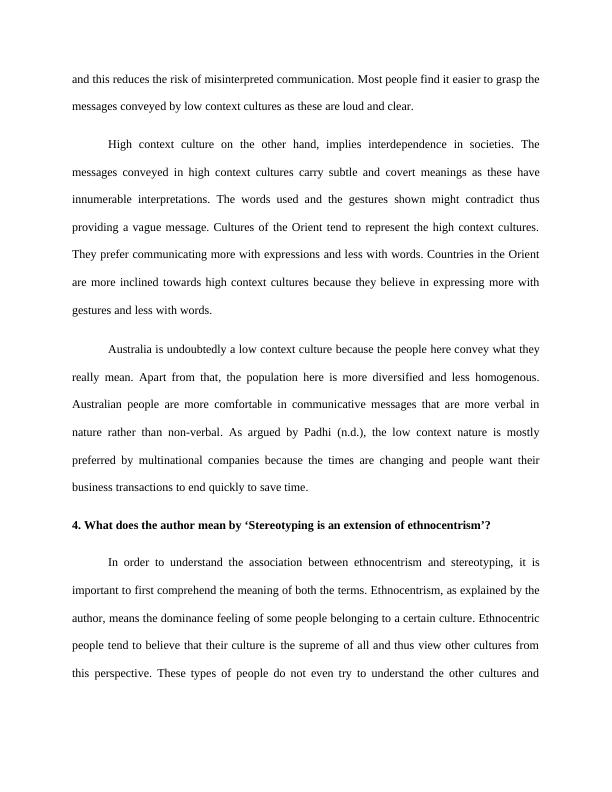Cross-Cultural Communication in Business
Added on 2021-06-14
11 Pages2920 Words146 Views
Running head: CROSS-CULTURAL COMMUNICATION IN BUSINESSCROSS-CULTURAL COMMUNICATION IN BUSINESSName of the StudentName of the UniversityAuthor note

1.What is the advantage of cross cultural communication (CCC) for business? Cross-culture refers to the amalgamation of different cultures for the specific purpose ofany organization. Cross-cultural communication (CCC) hence, can be said to be the effectivecommunication established across cultures. Businesses can benefit largely by conductingefficient cross-cultural communication. The list describing the advantages of CCC is notexhaustive but some advantages as mentioned by Padhi (n.d.) could be included. The first advantage of CCC is that it can give an upper hand to a business negotiator overhis or her competitor. An employee who is well-versed in a foreign language where the businesshopes to expand, might prove to be the reason for success as people would prefer those whovalue their culture and language is a part of culture. The second advantage of CCC is that it helps organizations establish a concrete plan ofaction to tackle the challenges of the global business environment. Developing an internalcommunication capacity can help businesses control and monitor the external threats. As the third advantage, CCC allows managers and subordinates of multinationalcompanies to interact with members of different cultures thus enhancing innovation. It alsoenhances managerial effectiveness.Fourth advantage of cross-cultural communication within the context of business is that itsaves the company from creating blunders while promoting any products or services in foreignnations. 2. According to the author, what are some of the measures to overcome the barriers tocross cultural communication?

The author states that cross-cultural communication faces obstacles due to severalreasons from management style to worker expectations, lack of understanding between staff andmanagers, presence of power distance and so on. In order to overcome these barriers, managersneed to possess the knowledge of non-verbal code systems of different cultures. It would assist increating communication relationships with others. According to the author, understanding the various dimensions of culture would providegreat help for businesses to conquer the barriers to CCC. Distancing from stereotyping,discriminating and making false judgments would help businesses succeed. In order to overcome the barriers to CCC that includes culture shock as well, businessesneed to change their management styles or adapt to the changing cultures of different nations.Culture shock refers to the initial experience people have after shifting to a new place havingdifferent culture. Intercultural competence is another measure that businesses can take to overcome CCCbarriers. It is the ability to take part in activities that involves a common communication code.Developing intercultural communication would equip the managers to appreciate differences inculture. All the aspects of intercultural communication starting from cognitive and behavioralthat ensures intercultural awareness and adroitness must be learnt in order to defeat the barriers. 3. What does the author mean by ‘low context’ and ‘high context’ cultures? Is Australialow or high context?Low context culture, according to the author encourages direct expression of ideas andfrankness in assessing situations. Managers in a low context culture are very blunt in expressing

and this reduces the risk of misinterpreted communication. Most people find it easier to grasp themessages conveyed by low context cultures as these are loud and clear. High context culture on the other hand, implies interdependence in societies. Themessages conveyed in high context cultures carry subtle and covert meanings as these haveinnumerable interpretations. The words used and the gestures shown might contradict thusproviding a vague message. Cultures of the Orient tend to represent the high context cultures.They prefer communicating more with expressions and less with words. Countries in the Orientare more inclined towards high context cultures because they believe in expressing more withgestures and less with words.Australia is undoubtedly a low context culture because the people here convey what theyreally mean. Apart from that, the population here is more diversified and less homogenous.Australian people are more comfortable in communicative messages that are more verbal innature rather than non-verbal. As argued by Padhi (n.d.), the low context nature is mostlypreferred by multinational companies because the times are changing and people want theirbusiness transactions to end quickly to save time.4. What does the author mean by ‘Stereotyping is an extension of ethnocentrism’? In order to understand the association between ethnocentrism and stereotyping, it isimportant to first comprehend the meaning of both the terms. Ethnocentrism, as explained by theauthor, means the dominance feeling of some people belonging to a certain culture. Ethnocentricpeople tend to believe that their culture is the supreme of all and thus view other cultures fromthis perspective. These types of people do not even try to understand the other cultures and

End of preview
Want to access all the pages? Upload your documents or become a member.
Related Documents
Cross Cultural Communication - Documentlg...
|9
|2006
|12
Cross-Cultural Communicationlg...
|9
|1895
|192
Intercultural Communication Challenges and Recommendations for BeautyPro Company in Chinalg...
|14
|1572
|442
Intercultural Managementlg...
|6
|1040
|54
Intercultural Communication Research Paper 2022lg...
|9
|1813
|50
Importance of Cross Cultural Communication in Businesslg...
|9
|1982
|430
